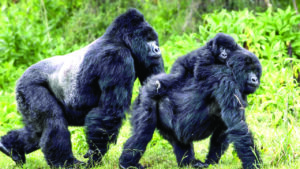By Beth Leermakers
Actions speak louder than words. In the animal kingdom, communication often occurs nonverbally.

Photo courtesy of Skyler Bishop for Gorilla Doctors
How much do you know about verbal and nonverbal animal communication? Take this quiz to find out —and learn a few interesting facts.
1. Which is NOT a way that animals communicate?
A. Dancing
B. Pheromones
C. Poop
D Electricity
E. None of the above
2. What animals waggle to communicate with [something]?
A. Birds of paradise
B. Clark’s grebes
C. Bees
D. Peacock spiders
E. All of the above
3. True or false. Elephants communicate via infrasound.
4. What animal changes color to fend off rivals and potential predators?
A. Cuttlefish
B. Squid
C. Octopus
5. What animal does NOT communicate through pheromones?
A. Ants
B. Snakes
C. Deer
D. Whales
E. Frogs
6. True or false. When a gorilla hums during dinner, he wants to chat with his family.
7. Cats purr when they are:
A. Content
B. Anxious
C. Greeting people or other cats
D. Sick
E. All of the above.
8. True or False. A wagging tail means a happy dog.
Answers:
1. E. None of the above. Many animals dance, often to attract a mate. Several animals communicate through pheromones (chemical signals produced through glands). White rhinos create huge, 10-foot-wide, communal piles of poop that contain societal and biological information, such as who’s the dominant male rhino and which rhinos are healthy, sick or ready for mating. Electric fish generate electric fields, using them to communicate with other fish via electroreceptors. The fish interprets the signal frequency and waveforms to determine the sender’s message.
2. C. Bees. While all these animals dance to communicate, only bees “waggle.” Waggling is a dance-like movement that tells other bees the direction and distance of the food source. When a bee discovers a nectar source, it heads back to the hive and waggles. By touching the waggling bee’s abdomen, the other bees learn where to find the food without having to be shown. The direction and speed of the dance indicate the nectar’s specific location.
3. True. African elephants make sounds with wave frequencies that are too low (under 20 herz) to be heard by humans. Infrasound is far from quiet to other elephants. One African elephant making an infrasound can be heard by another elephant more than 10 km (6.2 miles) away. Alligators, giraffes, rhinoceroses and whales also use infrasonic communication.
4. B. Squid. Squid and cuttlefish change color to attract mates or signal they’re already taken. Squid also change color to deter rivals or scare off predators. When one squid threatens another, it can spark a vibrant, colorful standoff.
The two engage in a dazzling display until one retreats. Impressively, squid can even multitask, showing an attractive color on one side while flashing a warning on the other. Octopuses use their color-changing abilities for camouflage and defense. When an octopus suddenly turns white with dark rings around its eyes, it’s a clear signal that it feels threatened and may be ready to attack.
5. D. Whales. Whales communicate primarily through sounds (clicks, whistles and pulsed calls). Ants use pheromones to leave scent trails that lead other ants to food sources or warn of danger. Snakes primarily communicate with other snakes through pheromones that provide information such as age, sex and reproductive maturity. Deer use pheromones to mark their territory, attract mates and warn other deer of predators. Male reed frogs produce pheromones to attract mates and/or to fend off rival males.
6. False. Dominant silverback gorillas decide on mealtimes and hum to call their companions (especially females, who are drawn to the musical alpha males) to the dinner table. When the gorilla hums while he’s eating, it means he’s enjoying his meal and doesn’t want to be bothered. When he’s silent, the alpha male is willing to talk.
7. E. All of the above. We often associate purring with a happy cat, but it can also be a sign of anxiety. When they’re anxious, some cats alternate between purring and meowing, perhaps trying to soothe themselves after a stressful situation such as a vet visit. Cats may utter a short, happy purr when greeting other cats or people. Cats may purr when they’re sick or in pain, possibly to ask for care.
8. False. A wagging tail is a sign of arousal: happy arousal, fear, excitement or even aggressive arousal. In general, the higher the tail and the faster the wagging, the greater the level of arousal. A flagging tail (straight up, wagging very fast) signifies high arousal. To determine whether the high tail means happiness or aggression, look at body language. A wiggly dog whose whole body seems to be wagging is happy, while body tension may signify aggression. A medium-height tail wag is usually a sign of a calmer, less aroused dog, while a low tail wag (or tail tucked between the legs) signals fear.
